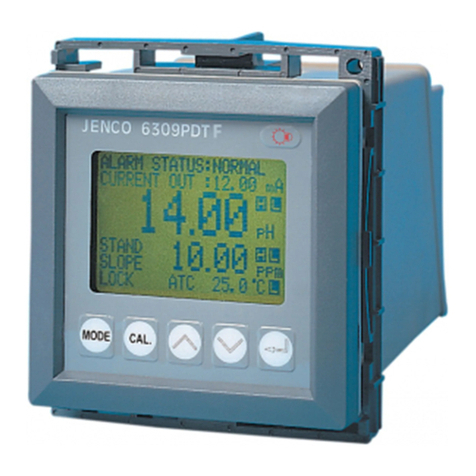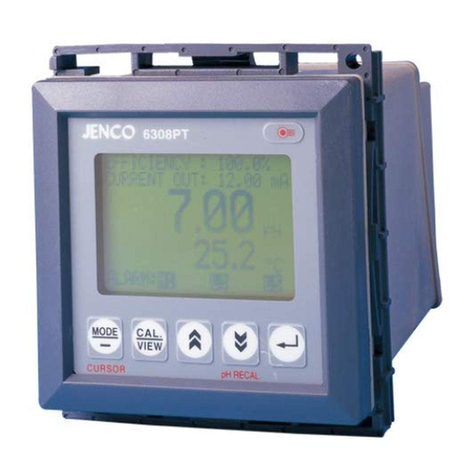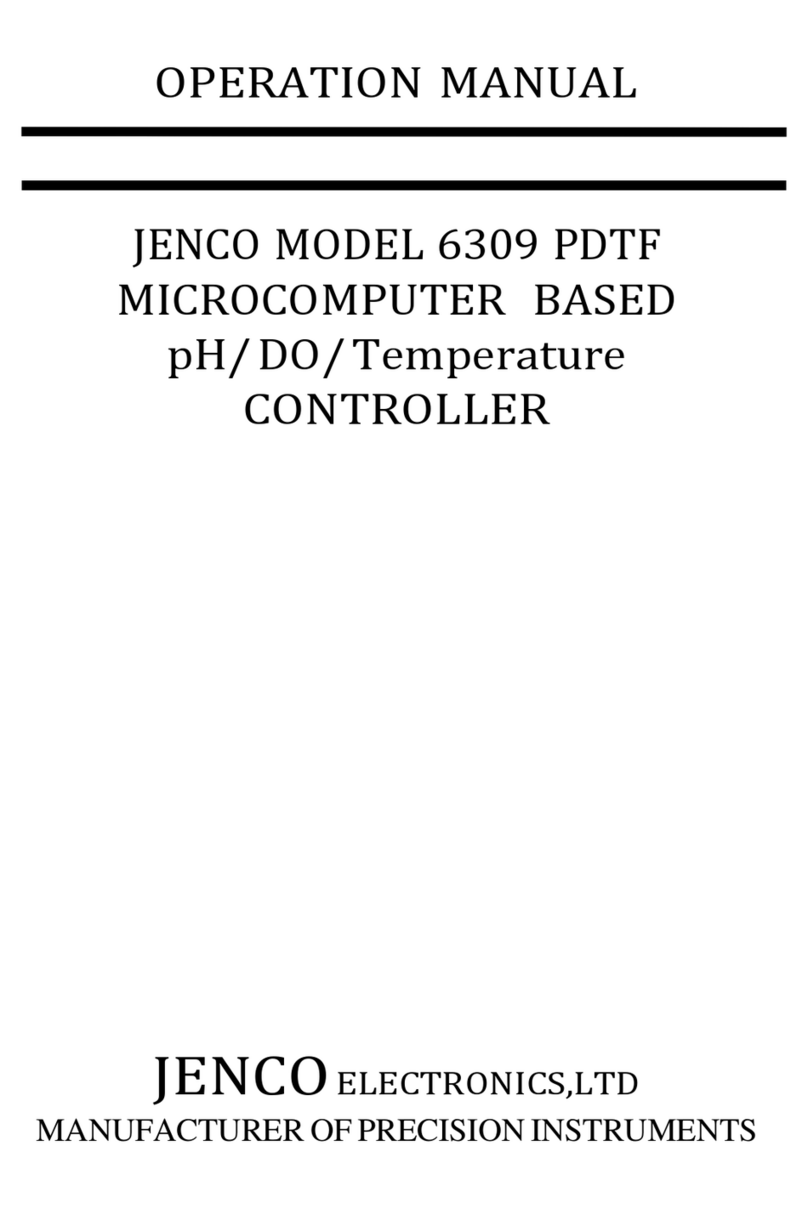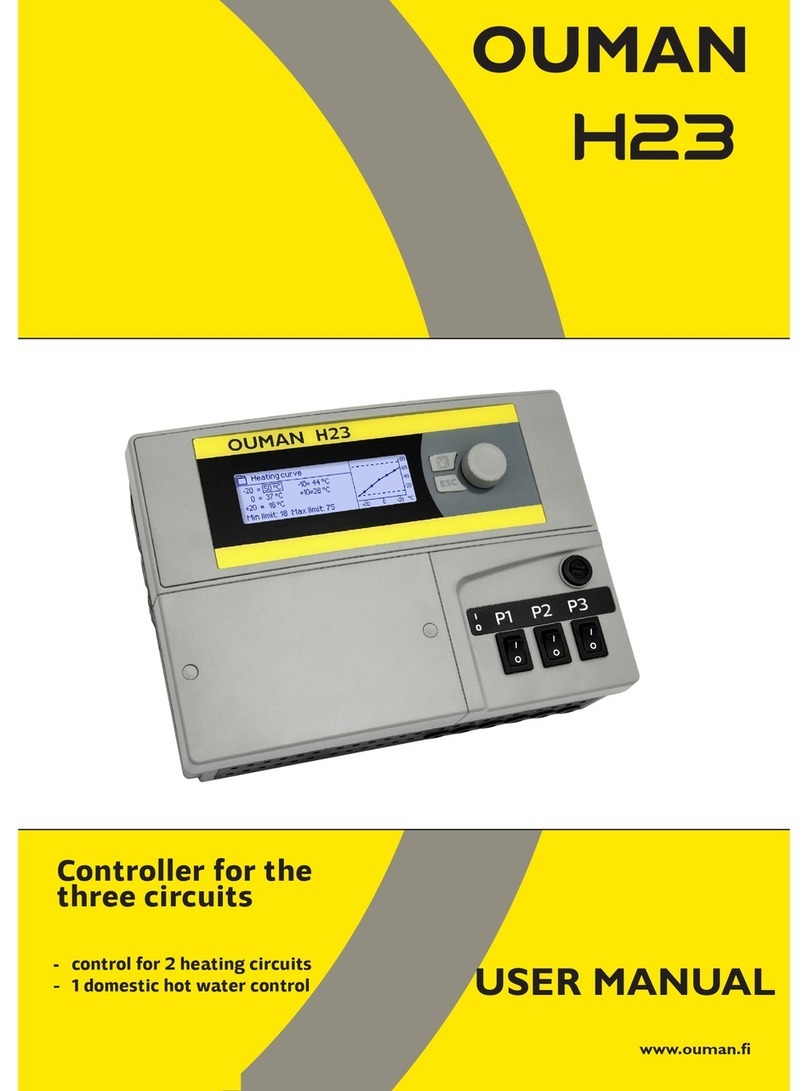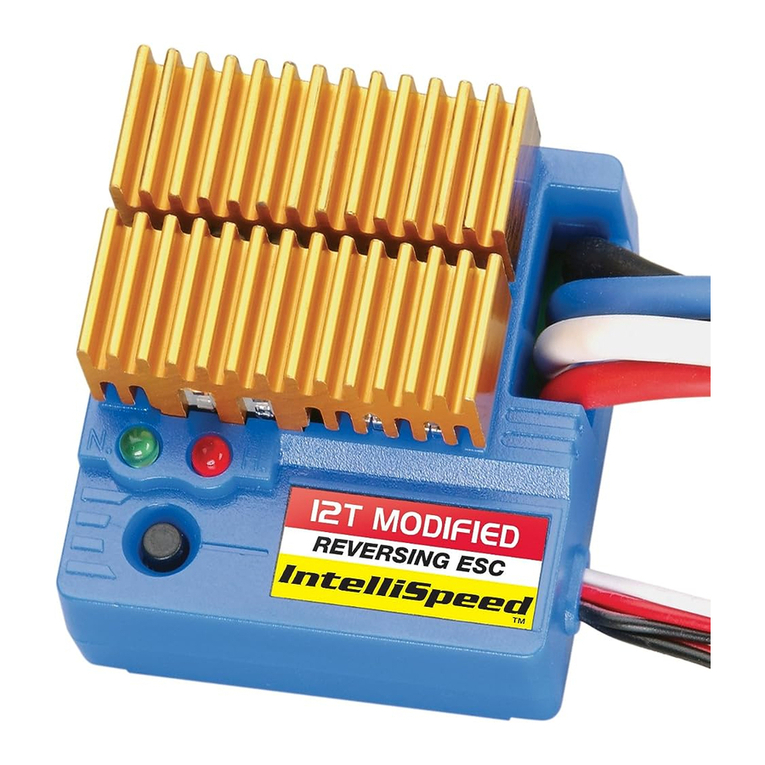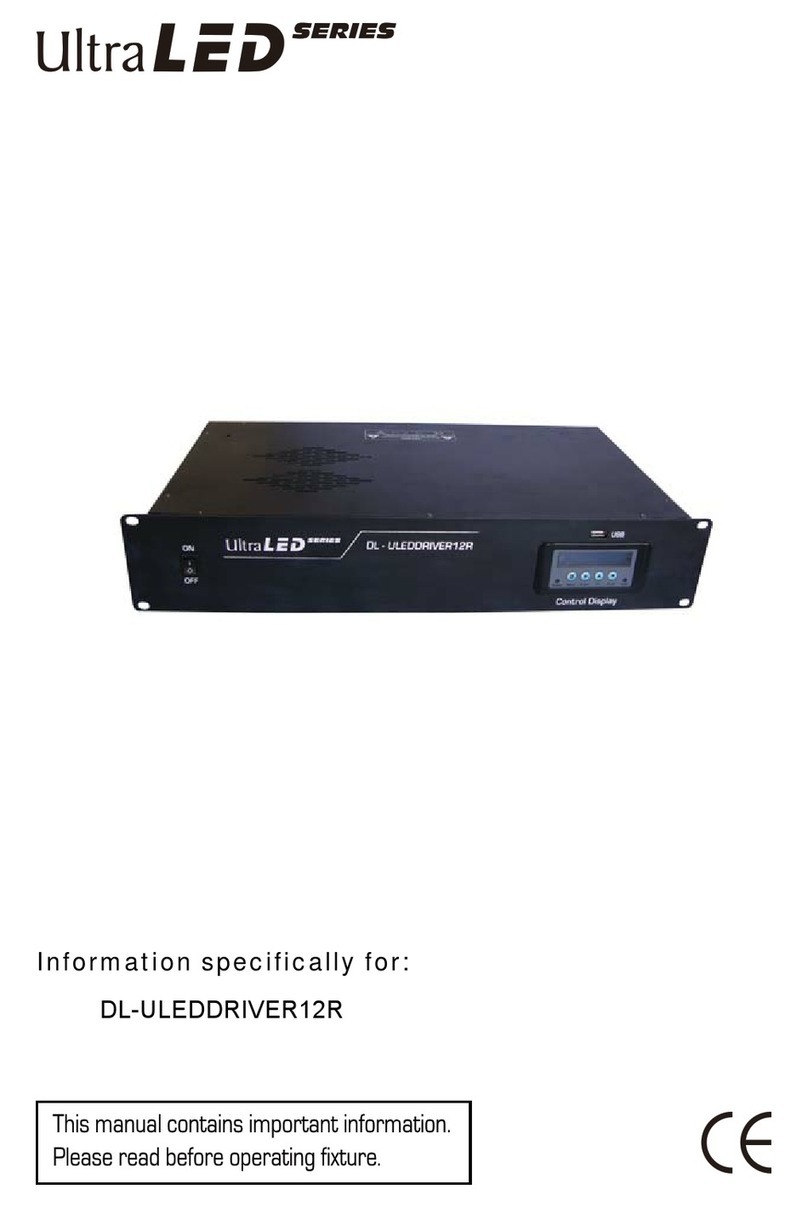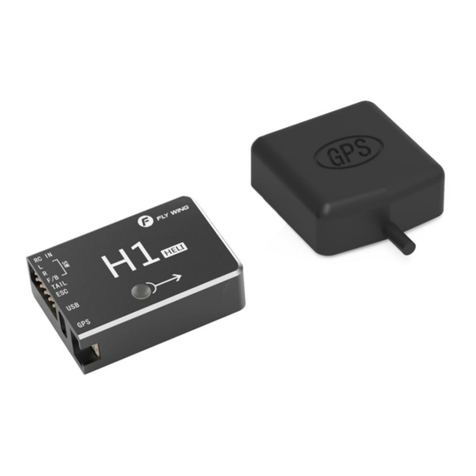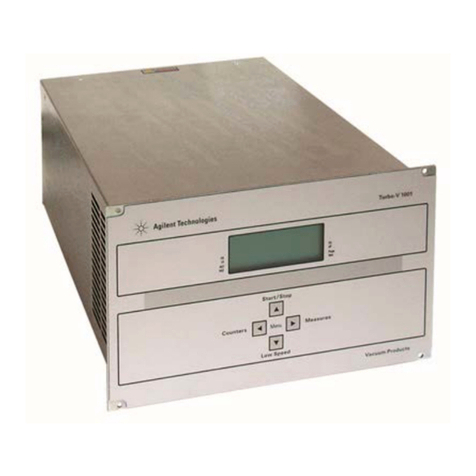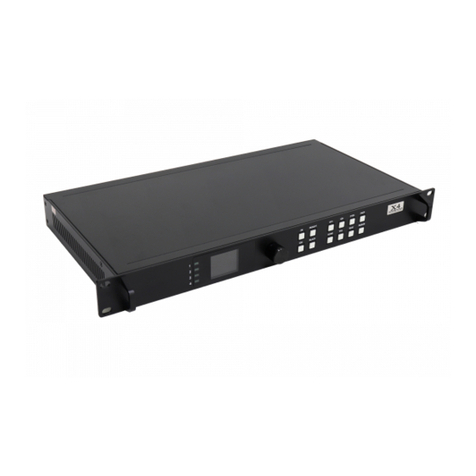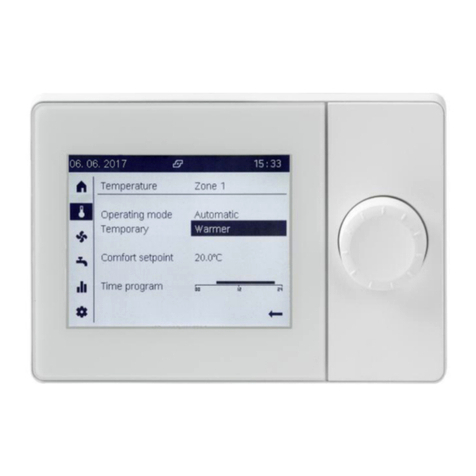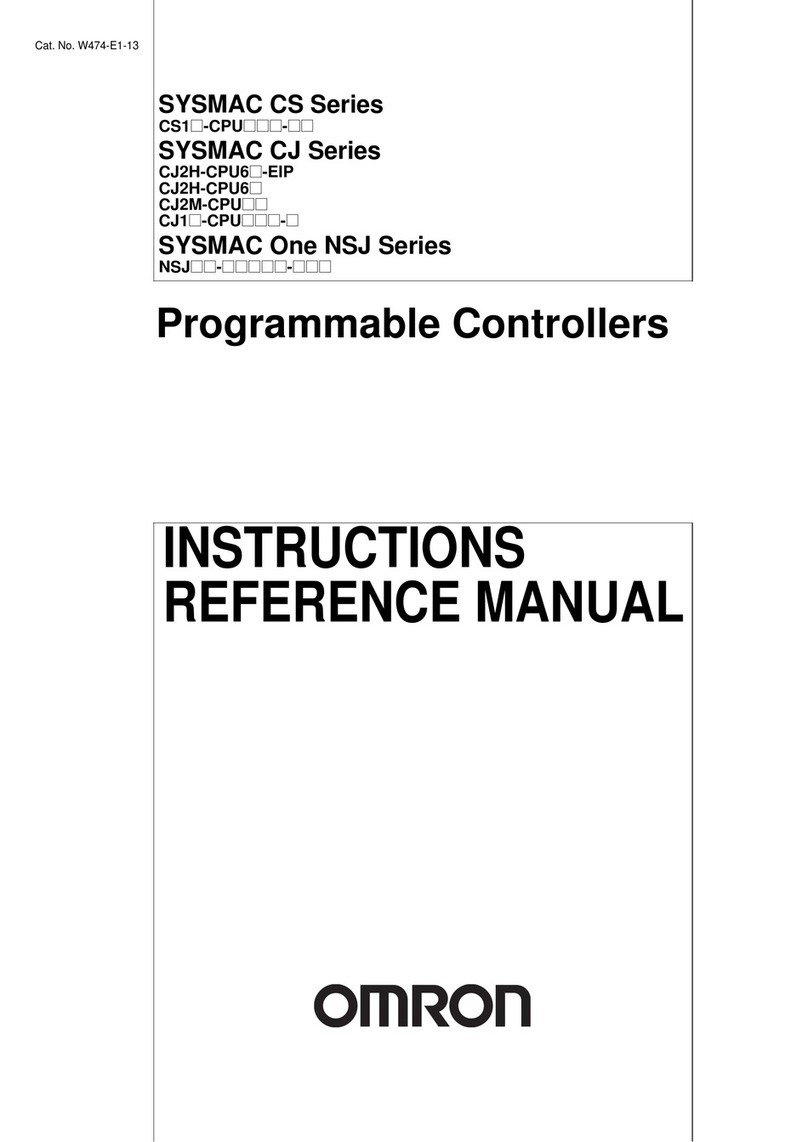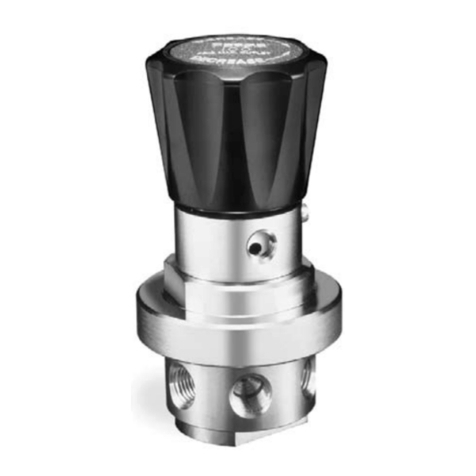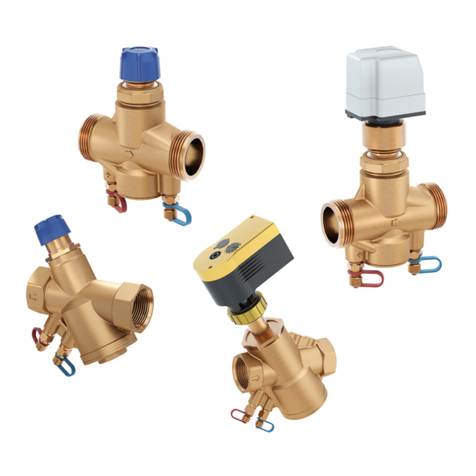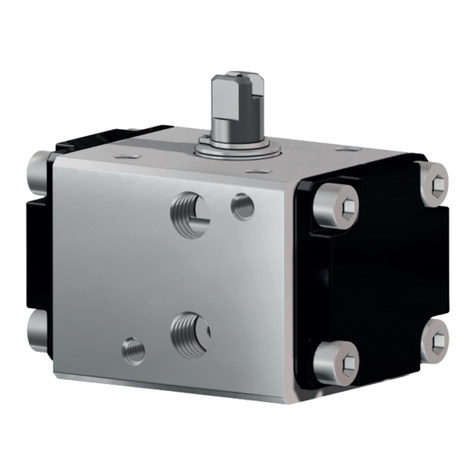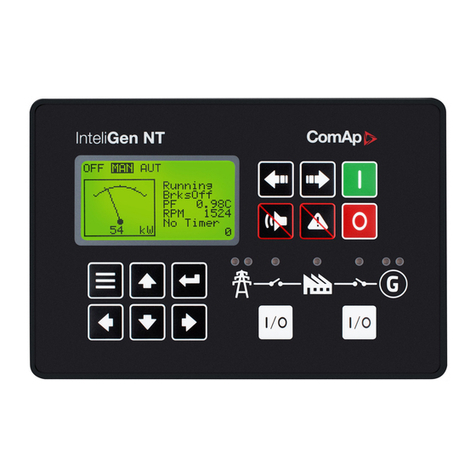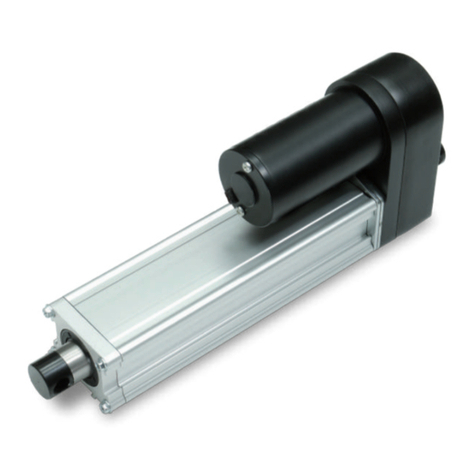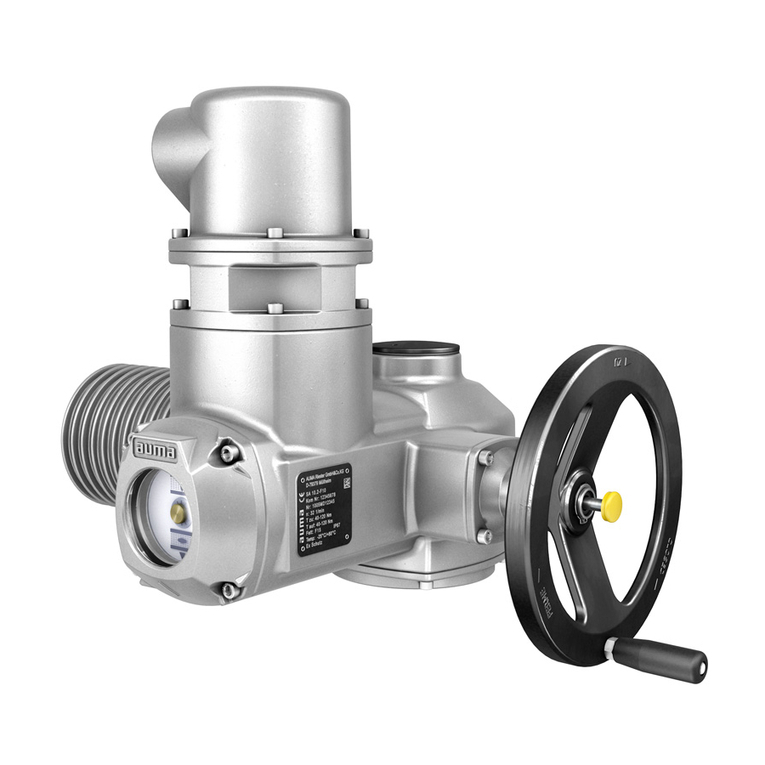JENCO 6308TuSS User manual

OPERATION MANUAL
JENCO MODEL 6308TuSS
MICROCOMPUTER BASED
TURBIDITY AND SUSPENDED
SOLIDS CONTROLLER
JENCO ELECTRONICS,LTD.
MANUFACTURER OF PRECISION INSTRUMENTS

2
CONTENTS Page
I. INITIAL INSPECTION and ASSEMBLY.............................................. 3
MOUNTING PROCEDURE....................................................... 3
II. GENERAL INTRODUCTION............................................................... 4
III. USING THE JENCO MODEL 6308TuSS........................................... 5
A. FRONT PANEL (Key function illustration)...................... 5
B. NORMAL MODE DISPLAY................................................ 7
C. REAR CONNECTORS....................................................... 8
D. TURNING ON/OFF THE INSTRUMENT............................ 9
IV. MODEL 6308TuSS MODES.............................................................. 10
A. MAIN DISPLAY MODE....................................................... 10
B. CALIBRATION/SETTING MODE....................................... 10
How to use the keys.......................................................... 11
a. PASSWORD CHECK page....................................... 12
b. USER SETTING page............................................... 13
c. CALIBRATION page................................................. 13
d. CONTROL SETTING page....................................... 17
e. CURRENT OUT SETTING page............................... 18
f. WASH SETTING page............................................... 18
g. RS-485 SETTING page............................................. 19
V. CONTROLLING THE RELAYS.......................................................... 20
A.ISOLATION VOLTAGE......................................................... 20
B.OUTPUT LOAD..................................................................... 20
C.RELAY ACTION, RELAY SETPOINT,
& HYSTERESIS VALUE........................................................ 20
D. TURBIDITY AND SUSPENDED SOLIDS RELAYS............. 21
VI. 4-20 mA ANALOG OUTPUT............................................................. 22
A. ISOLATION VOLTAGE........................................................ 22
B. OUTPUT LOAD.................................................................... 22
C. TURBIDITY AND SUSPENDED SOLIDS
LINEAR OUTPUT................................................................ 22
VII. SPECIFICATIONS............................................................................ 24
VIII. WARRANTY.................................................................................... 25

3
I. INITIAL INSPECTION and ASSEMBLY
Carefully unpack the instrument and accessories. Inspect for
damages made in shipment. If any damage is found, notify your
Jenco representative immediately. All packing materials should be
saved until satisfactory operation is confirmed.
MOUNTING PROCEDURE
1. Make a cutout on any
panel, with a thickness
of 1/16 in. (1.5 mm) to
3/8 in. (9.5mm).
2. Remove the mounting
assembly from the
controller and insert the
controller into the
cutout.
3. Replace the mounting
bracket assembly onto
the controller and
secure the controller to
the mounting panel.
Warning:
If the equipment is used in a manner not specified by the
manufacturer, the protection provided by the equipment may be
impaired.
Cleaning the instrument:
1. Be sure to remove the power before attempting to clean the
meter.
2. Use a lint free cloth and clean water or neutral detergent.
3. Wipe the outer surface of the instrument only.
4. Wipe-dry the instrument before powering again.

4
II. GENERAL INTRODUCTION
The Jenco Model 6308TuSS (Turbidity and Suspended Solids)
System is a rugged microprocessor based instrument assembled in
a watertight ¼ DIN case, designed for use in laboratories and
process control applications.
The model 6308TuSS microprocessor performs a self-diagnostic
routine every time you turn on the unit providing you with basic
information on the stability of the instrument.
The system simultaneously displays Turbidity and Suspended
Solids, relay status and current output in one graphic LCD screen.
The model 6308TuSS is equipped with 3 relays (2 programmable
high or low relay for Turbidity and Suspended Solids, 1
programmable for external cleaning); Turbidity and Suspended
Solids relays are hysteresis driven and configurable to CENTER
mode. The system also has a isolated 4-20mA analog output for
the Turbidity and Suspended Solids display.

5
III. USING THE JENCO MODEL 6308TuSS
A. FRONT PANEL
1. The [MODE/-] key.
1a. In the turbidity measuring page (TC-100、TC-500 、TC-
3000), press the “MODE” key to switch between the NTU and
the FNU turbidity units. The default is in NTU unit.
1b. In Calibration/Setting mode, pressing this key will move
the cursor to the next digit of the current active parameter.
1c. In Calibration/Setting mode, pressing this key for two
seconds will move you back to the previous parameter.

6
2. The [CAL / VIEW] key.
2a. In the normal mode, the display will go to
Calibration/Setting mode if you press this key for about two
seconds.
2b. During Calibration/Setting mode, pressing this key will
switch to the next available Calibration/Setting page.
Pressing this key at the last Calibration/Setting page will
return the user to the normal mode.
3. The []UP key.
During Calibration/Setting mode, pressing this key will
increment the current blinking digit of the active parameter.
4. The []DOWN key.
During Calibration/Setting mode, pressing this key will
decrement the blinking digit of the active parameter.
5. The []ENTER key.
During Calibration/Setting mode, pressing this key will save
the current modified parameter and move to the next
parameter on the page. If the parameter is the last one in the
page then it will move to first parameter on the next available
page.
6. The [ ] LIGHT key.
This key will turn on or turn off the backlight of the LCD.
The backlight will automatically turn off if there is no key
activity for about two minutes.

7
B. NORMAL MODE DISPLAY
1. TC-100 annunciator- this is the sensor selection mode. The
model 6308TuSS can work with 5 different 5 sensors, they are:
TC-100、TC-500、TC-3000、TCS-1000 and TS-MXS-A.
2. CURRENT OUT - this will display the actual reading of the 4-
20mA output. At power-on this will show “OFF” for about 3
seconds before going to the normal display mode. After exiting
the Calibration /Setting pages, a “FROZEN” message will be
displayed for about 3 seconds if the unit is not password locked.
3. 100.00 NTU annunciators- Turbidity display and unit (NTU or FNU)
or Suspended Solids display and unit (mg/L).
4.
annunciator - this will be displayed if Calibration/Setting
pages are password locked meaning the user can’t
change the values unless the correct 4 digit password has been
entered.

8
5. H1 (High action relay 1) or L1 (Low action relay1) annunciator
- This is the status of the Turbidity or Suspended Solids relay 1, if
this is displayed then the relay is ON. H1 means the relay action
is HIGH while L1 means the relay action is LOW.
6. H2 (High action relay 2) or L2 (Low action relay2) annunciator
- This is the status of the Turbidity or Suspended Solids relay 2, if
this is displayed then the relay is ON. H2 means the relay action
is HIGH while L2 means the relay action is LOW.
7. C (Cleaning relay3) annunciator - “C” will appear when the
external cleaning relay is ON.
C. REAR CONNECTORS

9
Before connecting the probes, relays, analog output, RS485 and
power cord be sure that you are connecting to the right terminal as
shown above. Remember that the unit is on once the user plugs in
the power cord to an AC power supply.
1. Connect the AC line to the rear of the instrument. The model
6308TuSS can be used with 115VAC or 230VAC 50/60 Hz.
Power consumption is 6 watts. Make sure the EARTH connector
is connected to the earth lead of the AC power line.
2. Connect the proper load to the output relays. Make sure that the
load does not exceed the relay rating, 5 Amp at 115VAC and
2.5Amp at 230 VAC.
3. Set the proper load to the 4-20mA-output connector. Make sure
that the load impedance is less than 500 Ohms.
CAUTION: Make sure you connect the AC power to the correct
AC terminals. Connecting incorrectly may damage the unit
permanently.
D. TURNING ON/OFF THE INSTRUMENT
By just plugging the unit to a
correct AC voltage the unit
will be ready for use. There
is no Power key so
unplugging and plugging the
unit will turn off or turn on
the unit respectively.
After the unit is turned on, it
will perform some basic self diagnostics and will display “OK” or

10
“BAD”. If you received any “BAD” messages turn off the unit and
turn it on again.
If the message persists then you might need to call your distributor.
(See IX. WARRANTY).
IV. MODEL 6308TuSS MODES
A. MAIN DISPLAY MODE
The unit will always start in main display mode once it is turned on.
This instrument is designed to provide 2 distinct measurements:
1. Turbidity - a measurement of turbidity in NUT or FNU.
2. Suspended Solids -a measurement of suspended solids in mg/L.
B. CALIBRATION/SETTING MODE
Pressing the [CAL/VIEW] key for about two seconds during the
main display mode will bring-up the first page of seven pages of the
Calibration/Setting mode. Pressing [CAL/VIEW] key will switch to
the next page. At the last page, pressing [CAL/VIEW] again will
return the meter to the main display mode.

11
Below is a simple flowchart showing the path of the [CAL/VIEW]
key:
How to use the keys
1. At main display you need to press and hold the [CAL/VIEW] key
for two seconds to change the display to VIEW SETTING PAGE
or if the instrument is password locked the display will go to the
PASSWORD CHECK page.
2. At the turbidity main display mode you can press the [MODE/-]
key to select the turbidity unit.
3. You need to press the [] or [] keys to increment or decrement
the numbers. For options in digit format, you need to press the
[MODE/-] key to move to the next digit . If you are satisfied with

12
the selection you made, you press the [ ]ENTER key to save
the changes and move to the next option.
4. If you don’t need to change the current blinking option just press
the [ ]ENTER key to move to the next option.
5. You can press and hold [MODE/-] key for two seconds and it will
move back the cursor to the previous option.
a. PASSWORD CHECK page
You will only see this page if the unit is password locked. To
change any settings or calibration you need to unlock the system to
remove the “PASSWORD LOCKED” message. You need to enter
the correct four digit number
on the “ENTER
PASSWORD” input. You
can still view all the pages of
the Calibration/Setting
mode if the system is
password locked by just
pressing the [CAL/VIEW]
key on this page. If the unit
is “PASSWORD LOCKED”
going to Calibration/Setting
mode will not affect the function of the relays and analog output.
CAUTION: If the unit is not locked then every time the user
enters the Calibration/Setting mode the relays and analog out
will be frozen.

13
b. USER SETTING page
You will only see this page if the
unit is not password locked.
This page is just a WARNING,
informing that all relays and
analog output are frozen, and
that you can calibrate and
change the settings.
NOTE: FROZEN means all the relays and the analog out will
maintain their last state until the user returns to main display
mode.
c. CALIBRATION page
1. At the "USER SETTING"
page, press [CAL/VIEW] key
to enter the first page of the
"CALIBRATION " mode. "TC-
100" icon will flash, use the
[] or [] key to select the
appropriate sensor. Press
[]ENTER key to confirm.

14
2. At this page, the meter will
display the measuring range
of the sensor selected. Press
[]ENTER or [CAL/VIEW]
key to continue. In the
Calibration mode, press the
[MODE/-] key for 2 seconds
will move you back to the
previous parameter.
3. At the CT1 calibration
page, rinse the sensor with
distilled water and place it in
0.00NTU (0.00FNU) standard
solution for one minute.
Press [ ]ENTER key to
confirm. The meter will
automatically enter the next
page.
4. At this page, the meter will
show a value. This is the
deviation value of the non-
calibrated senor from
0.00NTU. Press [ ]ENTER
key to enter the automatic
calibration mode. The "WAIT"
icon will flash. When the
"WAIT" icon stops flashing,
the meter will automatically
enter the next page.

15
5.At this page, press [ ]
ENTER key to save the
calibration. The meter will
show CT1 at 0.00NTU and
CT2 at a random value. One
point calibration is now
complete. Press [CAL/VIEW]
key to go to "CONTROL
SETTING" page or continue
second point calibration.
(NOTE: For taking general turbidity or suspend solids
measurements for the 6308TuSS, one point calibration is
suffice).
6. For CT2 calibration, rinse
the sensor with distilled water
and place it the second set of
standard solution for one
minute. The meter will show a
certain NTU value. This is the
deviation value of the non-
calibrated senor from the
second set of standard
solution.
Press [ ]ENTER key to
enter the manual calibration page. The first digit will flash. Use the
[] or [] key to select the proper numeral. Press [MODE/-] key to
go to the next digit.
IMPORTANT: Any calibration value cannot exceed 80% from
the full scale.

16
7.When the proper value of
the second standard solution
is selected, press [ ]
ENTER key to save. Two
point calibration is now
complete. Press [CAL/VIEW]
key to go to "CONTROL
SETTING" page or continue
third point calibration.
8. Repeat steps 6 and 7 for
the third, forth and fifth point
calibration.
NOTE: At any stage during calibration, you can press the
[MODE/-] for 2 seconds to go back to the previous calibration
point. By doing so, the meter will erase the value set previous
for the calibration point.

17
d. CONTROL SETTING page
1. HI or LO RELAY 1 – the
action for this relay is
changeable, you can choose
“HI” action or “LO” action. (In
HI-action the relay will turn on
if the turbidity or suspended
solids reading is greater or
equal to RELAY1 value, in
LO-action the relay will turn off
if the turbidity or suspended
solids reading is greater or equal to RELAY1 value, which is
modified by the hysteresis value. See chapter V. CONTROLLING
THE RELAYS ).
User can use [] and [] keys to select the relay1 action and press
[]ENTER key to save the setting. After you select the RELAY1
action you can now select the RELAY1 set point. Use [] and[]
keys to change the blinking digit, use the [MODE/-] key to select
another digit and the [ ]ENTER key to save the new set point
value.
2. HI or LO RELAY 2 – function & setting procedures same with
RELAY 1
3. The hysteresis value setup: Users can press [] or [] and
[MODE/-] keys to input the appropriate hysteresis value. When the
set value is confirmed press the [ ]ENTER key. If the hysteresis
value setting is too small it may cause relay to chatter. Please enter
the appropriate Hysteresis value based on S.P + / - ½ (H.V.)

18
Note: The hysteresis value can be set within the range
corresponding to the measured electrode set. The user enters
the current setting screen after setting up the Hysteresis value.
e. CURRENT OUT SETTING page
1. 4mA OUT - User can
press [] or [] and
[MODE/-] key to enter the
desired values. Press the []
ENTER key when finished.
(See chapter VI. 4-20mA
OUTPUT.)
2. 20mA OUT - Repeat the
same setting procedure of 4mA OUT for 20mA OUT setup. When
the 20mA OUT setup is complete, the user enters to the “WASH
SETTING”page. (See chapter VI. 4-20mA OUTPUT.)
f. WASH SETTING page
If the cleaning device is set to auto run, any one of the setting
values reaches to zero
terminates this function. To
initiate the cleaning function,
the user can input the time in
seconds by using the [],
[] and [MODE/-] key. (The
default time is 0000 second
and range from 0000 to 9999
seconds). To terminate the
cleaning function, the user
can input the time in hours by
using the [], [] and
[MODE/-] key. (The default time is 000 hour and range from 000.0 to

19
999.9 hours). When the external cleaning is turned on, it will
display "C" on the screen. After finishing the equipment wash relay
setup, the user enters to the “RS485 SETTING”page.
g. RS-485 SETTING page
RS485 with MODBUS communication protocol.
1. RS485 PARITY:- the
communication is in the
format of EVEN, ODD and
NONE.
2. RS485 ID:- this is the
unique ID/Address for the
unit. If you are connecting
multiple model 6308TuSS or
other Jenco models for
logging purposes then this ID/Address must be unique for each
connected unit. This ID/Address is the same address that must be
used by the PC program to communicate with this unit.
It is recommended to use a standard shield twisted pair
cable for optimum RS-485 communications.
3. PASSWORD SET - this is your security code if the unit is locked
the value here will not be available. You need to input the correct
code in the PASSWORD CHECK page.
CAUTION: You are is responsible in remembering your
password number otherwise you would no be able to calibrate
or change the settings.

20
V. CONTROLLING THE RELAYS
A. ISOLATION VOLTAGE
The maximum isolation voltage of the relay output contacts is 1500
VDC. The voltage differential between the relay output contacts and
the load should not exceed 1500 VDC.
B. OUTPUT LOAD
The current through the relay output contacts should not exceed 5
Amp at 115 VAC and 2.5 Amp at 230 VAC in order not to cause
permanent damage to the relay contacts. This rating is specified for
resistive loads only.
C. RELAY ACTION, RELAY SETPOINT & HYSTERESIS VALUE
Relay Action
Effective RELAY-ON
Set Point
Effective RELAY-OFF
Set Point
HIGH
S.P.+ ½(H.V.)
S.P. -½ (H.V.)
LOW
S.P.-½ (H.V.)
S.P.+½ (H.V.)
S.P. = Relay Set point
H.V.= Hysteresis value (Dead Band)
If the relay action is set to HIGH and the hysteresis mode is
CENTER, the relay will turn ON at [(RELAY SETPOINT) + (0.5 *
hysteresis value)], and will turn OFF at [(RELAY SET POINT) - (0.5
* hysteresis value)].
If the relay action is set to LOW and the hysteresis mode is
CENTER, the relay will turn OFF at [(RELAY SET POINT) + (0.5 *
hysteresis value)], and will turn ON at [(RELAY SET POINT) - (0.5 *
hysteresis value)].
Table of contents
Other JENCO Controllers manuals
